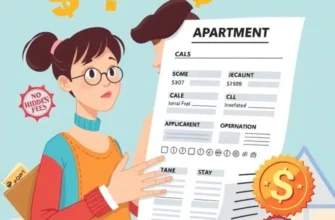Navigating the world of rental properties can be an exhilarating yet daunting experience for young adults, first-time renters, and families. You might find yourself daydreaming about your perfect home, only to feel a chill when staring down a lengthy lease agreement. The thrill of signing on the dotted line can quickly sour if you overlook some crucial details. Did you know that lease agreements are as varied as New York pizza toppings? Just as you wouldn’t throw pepperoni on a pineapple pizza, you need to be on the lookout for certain red flags in your rental lease that could turn into an unexpected headache! Whether you’re recently graduated, moving in with your partner, or trying to find the right bump in the perfect family nest, keeping an eye out for these warning signs can save you from future rental rumbles.
The Classic Lease Fog: What’s Hidden Between the Lines?

Unraveling a rental lease agreement can appear daunting, especially when faced with complex legal jargon that might conceal unwelcome surprises. Understanding common terms and differentiating between regular and red-flag language is crucial. Let’s delve into several key phrases and conditions that require careful scrutiny before you sign on the dotted line.
First off, the term “tenant responsibility” can be a catch-all phrase potentially laden with pitfalls. While it’s reasonable for tenants to be accountable for normal wear and tear, the term should not justify the imposition of outrageous maintenance duties. Look out for clauses that demand you handle repairs—especially on aspects such as plumbing or electrical systems—as these might indicate an attempt to shift undue burden onto you.
Be wary of “optional” fees that are vaguely defined within the lease. Often, these can include charges for amenities or services that you may not even utilize. For instance, unreasonably priced, compulsory parking fees, or seasonal heating charges based on imprecise calculations, are some examples of fees that can greatly inflate your monthly expenses. Ask for a detailed breakdown of all additional fees and ensure they are accurately reflected in the lease.
Another common lease element that can hide traps is the automatic renewal clause. If not clearly defined, it can transform your lease contract into a long-term commitment without your active consent. Make sure any renewal terms require explicit agreement from both parties rather than automatically rolling over.
In cases where lease terms feel ambiguous, don’t hesitate to act. Engage your landlord in a discussion about any confusing language. A proactive approach involves requesting written clarification or even proposing the inclusion of clear terms that both parties agree upon. Never assume your interpretation aligns with that of your landlord’s; disparities here can lead to future disputes.
Furthermore, when deciphering leasing terms, it’s an invaluable practice to cross-reference state-specific rental laws. Resources such as Rental Laws by State can arm you with the knowledge needed to question dubious clauses that may flout local regulations.
Finally, ensure that all promises made verbally by either party are enshrined in the lease in written form. This includes additional perks like access to facilities, pet policies, or discounts. As oral agreements can easily be forgotten or disputed, having a documented version protects both the tenant and landlord.
By being meticulous in your lease scrutiny, you avoid falling into common pitfalls that might otherwise catch you off guard. Even the most daunting lease agreements can be navigated successfully with diligence and attention to detail.
Fees, Fees, Fees: The Sneaky Culprits

When you’re considering your next rental, the alluring headline of an affordable monthly rate might get you in the door. Yet, before you know it, you’re faced with a barrage of additional fees. These can swiftly turn a budget-friendly option into an unexpected financial burden.
Among the first surprises are application fees. Landlords and property management companies often charge these fees, ranging from $25 to more than $100, to cover background and credit checks. While some fee is standard, exorbitant charges can be a red flag. Always inquire if the application fee is refundable if not accepted, or if it can be applied to your first month’s rent.
Once through the application process, you might face an array of move-in costs. Familiar culprits include a security deposit, often equal to one month’s rent, and in some regions, first and last month’s rent. In this stack of upfront costs, watch out for unexplained administrative fees. These fees might be for “processing” paperwork or “initiating” maintenance services. Always ask for clear documentation and justification for any administrative charges.
Other fees can manifest as move-in fees, which some landlords charge to cover potential damage during your transition into the unit. While this fee is relatively common in urban areas, it should be transparent and reasonable—typically under $500. If a prospective landlord refuses to itemize what this fee covers, it could be a sign that costs aren’t being managed properly.
As you’re settling into your new abode, utilities and maintenance fees are next on the list. Establish whether your rent includes utilities like water, gas, and electricity, or if these will be an additional cost. Transparency in what’s included is crucial. Some leases also sneak in maintenance fees like pool upkeep or common area cleaning. Ensure these are explicitly outlined in your agreement.
Negotiating these fees might not always be straightforward, but it’s worth attempting, especially when dealing with a private landlord. Express your eagerness to start a good tenancy relationship, highlighting your stable income or solid references. Research other listings in the area to understand what similar properties charge, and use this information as leverage.
When fees do seem excessive, don’t hesitate to question their necessity. If faced with resistance during negotiations, suggest alternatives, such as paying a slightly higher rent in lieu of some one-time fees.
Young renters should educate themselves on their rights and local rental laws to avoid falling victim to unscrupulous practices. For a deeper understanding of what rental agreements should entail, check out this handy guide to rental laws by state. Keeping informed keeps you empowered.
Ultimately, vigilance is key. Keep an eye on detail, and question any fee that seems out of place. By mastering the art of fee identification and negotiation, you’ll be better positioned to secure a truly affordable rental home.
Final words
Ultimately, being a savvy renter means staying informed. By keeping an eye out for red flags in your rental lease, you can spare yourself from the pitfalls that catch many off-guard. Awareness of tricky terminology, hidden fees, and unclear responsibilities is your best defense against potential frustrations. Each of these red flags can signal more than just a tough negotiation; they might hint at future challenges. So equip yourself with knowledge, stay proactive in your search, and cultivate your ideal living space—sans the stress!









